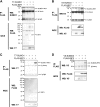Virus infection triggers SUMOylation of IRF3 and IRF7, leading to the negative regulation of type I interferon gene expression
- PMID: 18635538
- PMCID: PMC2533075
- DOI: 10.1074/jbc.M804479200
Virus infection triggers SUMOylation of IRF3 and IRF7, leading to the negative regulation of type I interferon gene expression
Abstract
Viral infection activates Toll-like receptor and RIG-I (retinoic acid-inducible gene I) signaling pathways, leading to phosphorylation of IRF3 (interferon regulatory factor 3) and IRF7 and stimulation of type I interferon (IFN) transcription, a process important for innate immunity. We show that upon vesicular stomatitis virus infection, IRF3 and IRF7 are modified not only by phosphorylation but by the small ubiquitin-related modifiers SUMO1, SUMO2, and SUMO3. SUMOylation of IRF3 and IRF7 was dependent on the activation of Toll-like receptor and RIG-I pathways but not on the IFN-stimulated pathway. However, SUMOylation of IRF3 and IRF7 was not dependent on their phosphorylation, and vice versa. We identified Lys(152) of IRF3 and Lys(406) of IRF7 to be their sole small ubiquitin-related modifier (SUMO) conjugation site. IRF3 and IRF7 mutants defective in SUMOylation led to higher levels of IFN mRNA induction after viral infection, relative to the wild type IRFs, indicating a negative role for SUMOylation in IFN transcription. Together, SUMO modification is an integral part of IRF3 and IRF7 activity that contributes to postactivation attenuation of IFN production.
Figures







References
-
- Akira, S., Uematsu, S., and Takeuchi, O. (2006) Cell 124 783-801 - PubMed
-
- Kawai, T., and Akira, S. (2006) Nat. Immunol. 7 131-137 - PubMed
-
- Takeda, K., and Akira, S. (2005) Int. Immunol. 17 1-14 - PubMed
-
- Yoneyama, M., Kikuchi, M., Natsukawa, T., Shinobu, N., Imaizumi, T., Miyagishi, M., Taira, K., Akira, S., and Fujita, T. (2004) Nat. Immunol. 5 730-737 - PubMed
Publication types
MeSH terms
Substances
Grants and funding
LinkOut - more resources
Full Text Sources
Medical
Molecular Biology Databases

